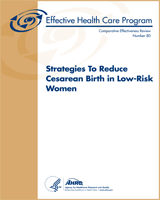This publication is provided for historical reference only and the information may be out of date.
Strategies to Reduce Cesarean Birth in Low-Risk Women
Comparative Effectiveness Reviews, No. 80
Authors
Investigators: Katherine E Hartmann, MD, PhD, Jeffrey C Andrews, MD, Rebecca N Jerome, MLIS, MPH, Rashonda M Lewis, JD, MHA, Frances E Likis, DrPH, NP, CNM, J Nikki McKoy, MPH, Tanya S Surawicz, MPH, and Stephaine H Walker, MD, MPH.Affiliations
Structured Abstract
Objectives:
The Evidence-based Practice Center systematically reviewed evidence addressing strategies to reduce cesarean birth.
Data Sources:
We searched MEDLINE® via PubMed and the Cumulative Index of Nursing and Allied Health Literature as well as the reference lists of included studies.
Review Methods:
We included studies published in English from 1968 to February 2012. We excluded publications that did not address a Key Question, were not an eligible study design, or did not aim to reduce cesarean birth among low-risk women.
Results:
Of the 97 studies included, 16 were good quality, 28 fair, and 53 poor. In this review, all studies compared the novel strategy to usual care or to variations in the same strategy. Few studies addressed prenatal strategies; the one such strategy that reduced cesarean was treatment of the cervix with hyaluronidase in the clinic at term to promote cervical softening. Strategies intended for use in labor included four trials that favored active management of labor, with 2.8- to 7.4-percent decreases in cesarean; one study showed a significant decrease. Doula support in labor was associated with significant reductions in cesarean (5.0 to 22.0%) in three studies. One of six trials of fetal assessment reported a significant reduction in total cesareans (20.6%). Three of eight trials of amnioinfusion reported a significant reduction in total cesareans (15 to 34.2%).
Virtually all studies within health care systems that changed policies or procedures evaluated strategies with more than one component. Seventeen of 31 studies reported statistically significant reductions in cesarean from 1.6 to 17.0 percent. Ten of the 17 effective strategies included audit and feedback of cesarean trend data to participating units and/or care providers, 7 included protocols for vaginal birth after prior cesarean, 6 included agreement on overarching labor and delivery guidelines, and 5 included active management of labor protocols. Overall, it is not possible to determine which components are definitively associated with reductions.
Conclusions:
No single strategy was uniformly successful in reducing cesareans. Strength of evidence was low to insufficient for all strategies. No approach dominated as a strategy appropriate to reduce use of cesarean among low-risk women in the United States.
Prepared for: Agency for Healthcare Research and Quality, U.S. Department of Health and Human Services1, Contract No. 290-2007-10065-I. Prepared by: Vanderbilt Evidence-based Practice Center, Nashville, TN
Suggested citation:
Hartmann KE, Andrews JC, Jerome RN, Lewis RM, Likis FE, McKoy JN, Surawicz TS, Walker SH. Strategies To Reduce Cesarean Birth in Low-Risk Women. Comparative Effectiveness Review No. 80. (Prepared by the Vanderbilt Evidence-based Practice Center under Contract No. 290-2007-10065-I.) AHRQ Publication No. 12(13)-EHC128-EF. Rockville, MD: Agency for Healthcare Research and Quality. October 2012. www.effectivehealthcare.ahrq.gov/reports/final.cfm.
This report is based on research conducted by the Vanderbilt Evidence-based Practice Center (EPC) under contract to the Agency for Healthcare Research and Quality (AHRQ), Rockville, MD (Contract No. 290-2007-10065-I). The findings and conclusions in this document are those of the authors, who are responsible for its contents; the findings and conclusions do not necessarily represent the views of AHRQ. Therefore, no statement in this report should be construed as an official position of AHRQ or of the U.S. Department of Health and Human Services.
The information in this report is intended to help health care decisionmakers—patients and clinicians, health system leaders, and policymakers, among others—make well-informed decisions and thereby improve the quality of health care services. This report is not intended to be a substitute for clinical judgment. Anyone who makes decisions concerning the provision of clinical care should consider this report in the same way as any medical reference and in conjunction with all other pertinent information, i.e., in the context of available resources and circumstances presented by individual patients.
This report may be used, in whole or in part, as the basis for development of clinical practice guidelines and other quality enhancement tools, or as a basis for reimbursement and coverage policies. AHRQ or U.S. Department of Health and Human Services endorsement of such derivative products may not be stated or implied.
None of the investigators have any affiliations or financial involvement that conflicts with the material presented in this report.
- 1
540 Gaither Road, Rockville, MD 20850; www
.ahrq.gov
